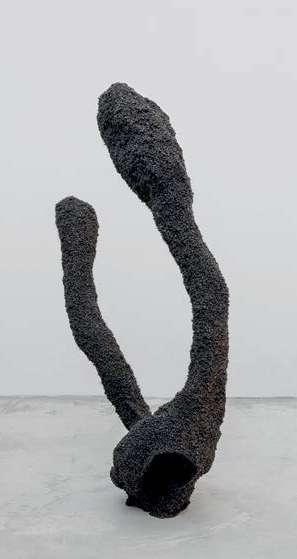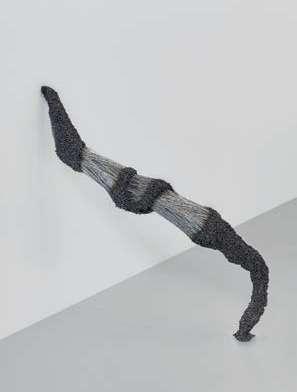Experimentos
Experiments on (what is) in-Existence
What to say when the work does not invite what, why, what for, or by which means kind of considerations? How to comment, to reflect on the artwork, and comfortably occupy the requested position when before pieces that unapologetically request the appreciator to set aside their critical certainties and to attend to the experiment before their eyes? What is left to the public, curator, the critic, who may praise themselves for being attuned to the questionings presented by apparatus of critique that address the colonial, racial cisheteropatriarchal matrix of the subject, when the work already exposes the limits of criticality, in both its theoretical and aesthetical modes.
Iagor Peres’ work unsettles the presumed position as it refuses — and the artist, even more explicitly, obviously — to be caught as a matter for knowing, something with which to become familiar, as an object for the understanding, or one to learn how to appreciate.
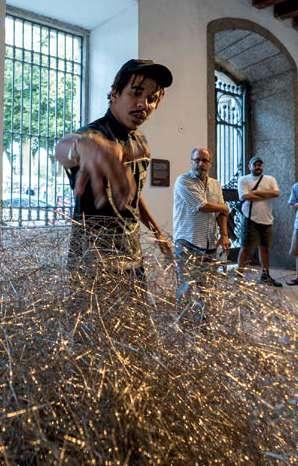
Iagor Peres e a obra Espectro I , 2023, desenho a partir de solda de aço inox, na abertura da exposição do Prêmio PIPA 2023 no Paço Imperial do Rio de Janeiro, RJ, foto de Fabio Souza // Iagor Peres and the work Espectro I , 2023, drawing made from welded stainless steel, opening of the PIPA Prize 2023 exhibition at Paço Imperial do Rio de Janeiro, Brazil, photo by Fabio Souza
Approaching the work with the quest(ion) of blackness, rebelry, which is the work it alone performs towards the dismantling of the post-Enlightenment arsenal and its occupation of every existing thing, under World and Nature, my task is arrested. Before the work’s rendering of rebelry I cannot but respond with meditation. Through that how, the manner the work does what it does, the procedure which, for lack of a better term I will call acategorical, that is, the work renders blackness experimentally, and as such without attributing it definition or definiteness.
How this manner of proceeding – or process, as the artist might call it – does what it does (and I say that knowing that this saying, Iagor will say, will become not just part but will also enter in the composition of the existing work) has to do with how it treats what we understand under terms such as body, object, and thing.
Having been hailed as an accomplice by the artist, I find it fair that the artist becomes part of this commentary. Nothing more than a couple of passages that comment on the work is here included. As it may be obvious by now, I do so not to use them as evidence but as raw material that composes Iagor Peres’ artwork.
O que dizer quando a obra não convida o quê, por que, para quê ou por que tipo de considerações? Como comentar, refletir, escrever sobre uma obra, ocupando confortavelmente a posição solicitada, quando diante de peças que, sem remorso, pedem que o apreciador deixe de lado suas certezas críticas e participe do experimento diante de si? O que resta ao público, curadoras, críticas, que podem se elogiar porque sintonizadas com os questionamentos apresentados pelo arsenal de crítica à matriz cisheteropatriarcal racial colonial do sujeito, quando a obra já expõe os limites da criticalidade, tanto em seu modo teórico quanto estético.
A obra de Iagor Peres perturba esta posição, a qual está sempre pressuposta ao recusar — e o artista o faz, ainda mais explicitamente, obviamente — ser capturada como uma questão de saber ou conhecer, algo com o qual devemos nos familiarizar, enfim, como objeto para o entendimento, ou algo para aprender a apreciar.
Abordando a obra desde a questão/questionamento que é a força da negridade – rebeldia, aquilo que ela apenas oferece para a tarefa de desmantelar o arsenal pós-iluminista e sua ocupação de todas as coisas existentes, sob os nomes de Mundo e Natureza –a tarefa crítica fica emperrada diante de como a obra performa a tarefa rebelde. A única maneira que encontro para responder ao questionamento é por meio da meditação. Dessa maneira, da maneira como a obra faz o que faz, o procedimento que, por falta de um termo melhor, chamarei de a-categórico, ou seja, a obra torna a negritude experimentalmente, e como tal sem lhe atribuir definição ou certeza.
Como esse modo de proceder – ou processar, como o artista poderia chamá-lo – faz o que faz (e o digo sabendo que este dizer, Iagor dirá, se tornará não apenas parte, mas também entrará na composição da obra existente) tem a ver com como trata o que entendemos sob termos como corpo, objeto, e coisa.
Tendo sido declarada cúmplice por Iagor Peres, acho justo que faça parte deste comentário. No que se segue incluo algumas passagens, comentários gerais sobre a obra. Como já pode ser óbvio, faço-o não para usá-los como evidência, mas como parte da matéria prima que compõe a obra.
1 Denise Ferreira da Silva, filósofa e artista visual brasileira, é professora titular no Departamento de Português e Espanhol e co-coordenadora do Critical Racial & Anti-Colonial Study-CRACS Co-Lab, na Universidade de New York, Nova Iorque, EUA. É professora na Universidade da Colúmbia Britânica, Vancouver, Canadá, onde também coordena o Social Justice Institute. // Denise Ferreira da Silva, a Brazilian philosopher and visual artist, is a full professor in the Department of Portuguese and Spanish and cocoordinator of the Critical Racial & Anti-Colonial Study-CRACS Co-Lab at New York University, New York, USA. She is a professor at the University of British Columbia, Vancouver, Canada, where she also coordinates the Social Justice Institute.
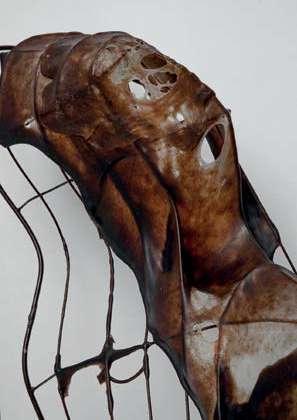
Sem T ítulo #1 da série Estrutura para Campos Densos, 2020 (detalhe), pele material e ferro, foto de Wallace Domingues // Untitled #1 from the series Estrutura para Campos Densos, 2020 (detail), material skin and iron, photo by Wallace Domingues
premiopipa.com // pipaprize.com 59 58 institutopipa.com
sobre (o que está) em-existência
Denise Ferreira da Silva1
“There is something that has always caught me in this process, which is the continuity of the gesture in space. For a long time, I immersed myself in dance and performance and it would lead me to a movement in which I would trigger my body, and it would do certain things that seemed to end there.”
Trusted into the position of appreciated when at the gallery, museum, biennale or by the art publication, I find relief accepting the work’s invitation to speculate.
Looking at images of Iagor Peres’ work over the past nine years, one cannot miss the resonances between the performances and the sculptures. What does not come about, at least not to me, is a term that would comprehend either or both. For, on the one hand, neither the performances nor the sculptures lend themselves to naming, to categorization, however, indicates something else at work. On the other hand, however, raciality suffuses the work both as a form (a term) that captures the context of its reception, and as its material also renders the performances and sculptures commentaries on the very colonial, racial, and cisheteropatriarchal context in which we encounter them.
Precisely this tension, I find, works through as each piece transfigures body, object, and thing precisely as it invites the public to attend to how it exists, to how its conditions of existence — which was the phrase used as a synonym for life in the 19th century — are constitutive of it as an existent. And those also include the artist, as Iagor Peres insists on reminding us. The “continuity of the gesture in the space” might as well be another name for existence when considered in the register of infinite movement, as viewers we encounter in existence
“Or they moved the space for a much shorter time than when the material skins appeared in my life, when we created ourselves. That was back in 2018, and inside and all that, the job was to think precisely the continuity of a gesture.“
What if Iagor Peres’ phrase “the continuity of a gesture” were to become that by which we approach body, object, thing, in existence?
The artist tells us that much when commenting on the work itself, on the relation between the artist and the work but also on how that “continuity” that occurs in space renders the work also and always unfinished, in existence. For it exists in relation, affecting and affected by shifts in temperature, air pressure, humidity as well as noise, light, neutrinos and dark matter, and so on — or to use Iagor Peres’s word, it is alive. Body, object, and thing are nothing more than the continuity of a gesture, both of the artist who first per-formed/preformed it and of the later per-formance/formation of everything else visible and non-visible with which it shares space.
The continuity of a gesture in space is a call for attention to inseparability also in regard to the mind, the subject, and the person.
In Iagor Peres’ work, implicancy does not come as a message to the appreciator (public, curator, interviewer, critic) in the first-person. Instead, it is coming out as the manner through which the artist turns us into accomplices in what happens to the materials that compose the object of art. It is the artistic object, as it gives
Colocada na posição de apreciadora quando na galeria, museu, bienal ou pela publicação de arte, sinto alívio ao aceitar o convite da obra para especular.
Olhando para as imagens da obra de Iagor Peres ao longo dos últimos nove anos, não se pode perder as ressonâncias entre as performances e as esculturas. No entanto, o que não ocorre, pelo menos para mim, é encontrar termo que abranja uma ou ambas formas artísticas. Pois, por um lado, nem suas performances nem suas esculturas se prestam à nomeação, à categorização. Ainda assim, há indicações de que haja algo mais em ação. Por outro lado, e ao mesmo tempo, a racialidade impregna a obra tanto como uma forma (um termo) que capta o contexto de sua recepção quanto como matéria prima, quando as performances e esculturas comentam sobre o contexto colonial, racial e cisheteropatriarcal no qual as encontramos.
Justamente essa tensão, acho, está em operação enquanto cada peça transfigura corpo, objeto e coisa justamente ao convidar o público a observar como ela existe, como suas condições de existência – que era a expressão usada como sinônimo de vida no século 19 – são constitutivas dela como existente. E essas também incluem o artista, como Iagor Peres insiste em nos lembrar. A “continuidade do gesto no espaço” poderia muito bem ser outro nome para a existência quando considerada no registro do movimento infinito, como espectadores nos deparamos com a obra em-existência
II.
E se a frase ”a continuidade de um gesto” se tornasse aquilo pelo qual nos aproximamos do corpo, do objeto, da coisa, da existência?
Iagor Peres artista nos diz isso muito ao comentar sobre a obra em si, sobre a relação entre artista e a obra, mas também sobre como essa “continuidade” que ocorre no espaço torna a obra também e sempre inacabada, na existência. Pois ela existe em relação, afetando e afetada por mudanças de temperatura, pressão do ar, umidade, bem como ruído, luz, neutrinos e matéria escura, e assim por diante – ou, para usar a palavra de Iagor Peres, ela está viva. Corpo, objeto e coisa nada mais são do que a continuidade de um gesto, tanto de Iagor, que primeiro o formou/pré-formou quanto da posterior per-formance/formação de tudo o mais visível e não visível com o qual compartilha espaço.
A continuidade de um gesto no espaço é um chamado de atenção para a inseparabilidade também em relação à mente, ao sujeito e à pessoa. Na obra de Iagor Peres, a implicação não vem como um recado ao apreciador (público, curador, entrevistador, crítico) na primeira pessoa. Ao contrário, está no modo como nos transforma em cúmplices do que acontece com os materiais que compõem seu
“Há algo que sempre me pegou nesse processo, que é a continuidade do gesto no espaço. Durante muito tempo, mergulhei na dança e na performance e isso me levava a um movimento em que acionava meu corpo, e ele fazia certas coisas que pareciam terminar ali.”
“Ou eles mudaram o espaço por um tempo muito menor do que quando as peles materiais apareceram na minha vida, quando nos criamos. Isso foi em 2018, e dentro e tudo mais, o trabalho era pensar justamente a continuidade de um gesto.”
premiopipa.com // pipaprize.com 61 60 institutopipa.com I. I.
II.
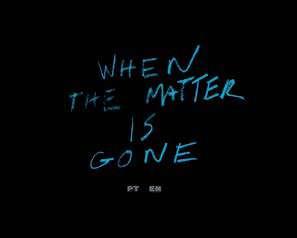
When the matter is gone jogo online // When the matter is gone online game
continuity to a gesture in space, affected by its condition of existence — that is, as it shifts and changes in/as space and in/as time — that establishes how the appreciator becomes part of it.
Two thoughts become unavoidable to me once I start to think of continuity in this manner, in the manner of Iagor Peres’ experiments: on the one hand, one cannot but wonder about whether or not when looking/touching something, even if not consciously so, one (the human thing) is also touched by that which has been part of the thing-in-existence. On the other hand, and consequently, one must wonder if her sensing (seeing, touching, smelling, hearing, tasting) of the thing-in-existence, the artistic object, commits the thing to the continuity of a gesture in space that she also exists as. Both questions, of course, also then request a consideration of how then the thing-in-existence, in so far as it comments on the workings of the colonial, racial, cisheteropatriarchal matrix, also affects the latter continuity, as also a gesture in space.
“(…) To think about the continuity of a thing that I position in space in a certain way and it ceases is to be only what I positioned when it repositions itself. When it exerts this transformation, it is itself in the world and replaces itself in another space, other than the space that I have placed. Maybe that’s not even my extension anymore. There is no formula between what it is, when, it ends, or when it becomes something. Agent is always in a relational field. Depending on the perspective, this object, or this living thing, changes in reference to me and in reference to it.” Slowly but surely, I hope, I have moved this commentary on Iagor Peres’s work, which now is another component of its in-existence, towards that which it unsettles which is precisely the two defining relations in the aesthetic field, the one between the artist and the work and the one between the appreciator and the work. How that is done – which is the manner through which, that which it obtains, the singularity of Iagor Peres’ experimental thinking, that is, art that intervenes by confronting (and in doing so exposing) the colonial, racial, cisheteropatriarchal matrix – I find, exemplifies something that, perhaps because of the protected place it has enjoyed through its 200 years old trajectory, the aesthetic alone seems able to afford.
That’s how, as the work itself, it does not allow categorization, it insists and persists in its refusal of a name. And it is precisely because it does so by dismantling that which is at the core of categorization — body, object, and thing —, by rendering it without form, without solidity or extension, that is, as movement, or, in Iagor Peres’s words, again, a continuity of the gesture in space.
Another way of saying the same thing is that Iagor Peres’ art work intervenes at the metaphysical and ontoepistemological level, as it refuses the very grounds of our thinking through imaging as a gesture that unravels the space of its occurrence. That gesture is precisely to trust the work to that which composes it and to that which is already in play, where it will exist. I, for one, could not resist the artist’s invitation to try, to experiment and appreciate existence acategorically. Once there, where the artist becomes just another existent that is also part of the artwork’s conditions of existence, is where the thinking of existence without violence, of implication instead of relation, and of undetermination, as space turns into the occurrence of uncertainty, that is the way of the experiment, which is/of every thing.
objeto de arte. É o objeto artístico, na medida em que dá continuidade a um gesto no espaço, afetado por sua condição de existência – isto é, à medida que se transforma no/como espaço e no/como tempo – que estabelece como a apreciadora se torna parte dela.
Duas questões tornam-se inevitáveis quando começo a pensar em continuidade dessa maneira, à maneira dos experimentos de Iagor Peres: por um lado, não se pode deixar de perguntar se ao olhar/tocar algo, mesmo que não conscientemente, alguém (a coisa humana) também é tocado por aquilo que fez parte da coisa-em-existência. Por outro lado, e consequentemente, deve-se perguntar se este sentir (ver, tocar, cheirar, ouvir, provar) da coisa-em-existência, o objeto artístico, compromete a coisa com a continuidade de um gesto no espaço que ela também existe como. Ambas as questões, é claro, também pedem uma reflexão sobre como então a coisa-em-existência, na medida em que comenta o funcionamento da matriz colonial, racial, cisheteropatriarcal, também afeta esta última continuidade, como também um gesto no espaço.
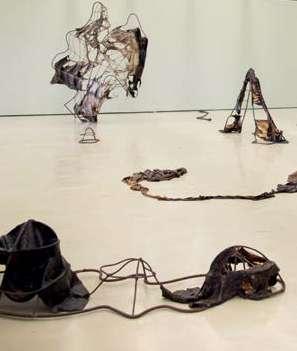
Exposição ‘Estrutura para Campos Densos’, 2020, Centro Cultural São Paulo, SP // Exhibition ‘Estrutura para Campos Densos’, 2020, Centro Cultural São Paulo, Brazil
Lentamente mas seguramente, espero, tenho movido este comentário sobre a obra de Iagor Peres, o qual agora é mais um componente seu em existência, para aquilo que inquieta, que são justamente as duas relações definidoras no campo estético, a entre o artista e a obra, e a entre a apreciadora e a obra. Como isso é feito – que é o modo pelo qual, aquilo que obtém, a singularidade do pensar experimental de Iagor Peres, ou seja, a arte que intervém confrontando (e ao fazê-lo expondo) a matriz colonial, racial, cisheteropatriarcal – eu acho, exemplifica algo com o qual, talvez pelo lugar protegido que desfrutou ao longo de sua trajetória de 200 anos, só a estética parece capaz de lidar. Dessa forma o faz, quer dizer, da maneira como a própria obra, não permite a categorização, mas insiste e persiste na recusa de um nome. E é justamente porque o faz desmontando o que está no cerne da categorização – corpo, objeto e coisa –, tornando-os sem forma, sem solidez ou extensão, isto é, como movimento, ou, nas palavras de Iagor Peres, novamente, uma continuidade do gesto no espaço.
Outra maneira de dizer o mesmo é que a obra de arte de Iagor Peres intervém no plano metafísico e ontoepistemológico, pois recusa os próprios fundamentos de nosso pensamento através da imagem como um gesto que destrincha o espaço de sua ocorrência. Esse gesto é justamente confiar a obra àquilo que a compõe e àquilo que já está em jogo, onde ela existirá. Eu, por exemplo, não resisti ao convite para experimentar, e apreciar existência acategoricamente. Uma vez ali, onde artistas tornam-se mais um existente, quer dizer, parte das condições de existência da obra, é onde o pensamento sobre existência sem violência, guiado pela implicação e adeterminação, assim como espaço transformam-se na ocorrência da incerteza, ou seja, no experimento, o qual é/de todas as coisas.
“(...) Pensar na continuidade de uma coisa que eu posiciono no espaço de certa forma e ela deixa de ser apenas o que eu posicionei quando ela se reposiciona. Quando ela exerce essa transformação, ela é ela mesma no mundo e se substitui em outro espaço, que não o espaço que eu coloquei. Talvez essa nem seja mais a minha extensão. Não há fórmula entre o que é, quando termina ou quando se torna algo. O agente está sempre em um campo relacional. Dependendo da perspectiva, esse objeto, ou esse ser vivo, muda em referência a mim e em referência a ele.”
premiopipa.com // pipaprize.com 63 62 institutopipa.com
III.
III.
Luiz Camillo Osorio conversa com Iagor Peres
Conversation between Luiz Camillo Osorio and Iagor Peres
How has dance impacted your formation and the construction of your poetics?
I feel as if I’ve answered this question in so many ways, it’s even hard to reinvent a path to approach the question once again, but here we go… What we learn with our bodies remains and is transformed into the body itself. Dance is a language that, to this day, influences my way of thinking about spatiality and composition, since this language involves not only the presence of bodies, but also their movement, displacement and transformation within and with space. It is through the body and the contact with dance that the invisible takes shape, establishing an energy and attention field which arises from the encounter between bodies that exist in that same space. To perceive and deal with often implicit dynamics that affect our relationships is to understand that, depending on the situation, crossing a 10-meter-wide street might feel as if it was 5 or 50 meters, or even a kilometer, depending on what awaits on the other side, the reasons behind the crossing, and many other factors. It is also through the intersection of dance and other languages, such as video, that I had my first contact with the idea of a hybrid language. Something that, essentially, could only exist in that way, since it would have to exist in that in-between and at the boundary of both, to the point that, if one language was dissociated from the other, they would no longer present the same strength and shape. Another movement that made me realize the importance of dance in my work is the idea of the recipe. In many of my works, the recipe presents itself as a repertoire of gestures archived in the body, keeping its knowledge and continuously transforming, even if in small doses. Something, we could say, that is kept in a space of memory, but is constantly happening and being revisited, in the present, during the making. Beyond all this, the movement of matter itself makes me think that there is a choreographic gesture of composition, since some of the works already include movement in time and its displacement and design in space.
Your movement towards sculpture emerges from your decision to take the protagonist role away from the body in the construction of language. Would that imply taking on materials as symbolic energies, as a play between what is formalized and what escapes?
People – sometimes even myself – often understand and describe this path of removing the body and approaching other corporealities as product of a desire guided towards sculpture, but it’s not necessarily that. The biggest challenge, which is still very much alive, is inhabiting the inbetween of languages and developing a thought that includes corporealities and corporeities that challenge or have nothing to do with the classical and modern foundations and that, through inconformity, interlace languages such as performance, dance, sculpture and painting, pointing towards instability and transformation, transgressing from their conformation to a supposed disappearance in space. A commitment, then, of establishing a relationship with a materiality that has agency over its transformations and therefore escapes, never truly becoming evidence. Aside from that point, there are movements in some works’ languages which are set in a way that invites the rethinking of those limits, sometimes bringing some of those words among them, sometimes establishing a direct critical counterpoint on the naming of a language, sometimes not. Bringing all this to this conversation interests me, because it precisely shows that a symbolic play would not be enough to develop what I was seeking.
Como a dança foi importante na sua formação e na construção da sua poética?
Sinto que eu já respondi essa pergunta de tantas formas que aqui fica até complexo reinventar um caminho para abordar essa questão mais uma vez, mas aqui vamos… Aquilo que se aprende com o corpo permanece e se transforma no próprio. A dança é uma linguagem até hoje presente na minha maneira de pensar espacialidade e composição, uma vez que essa linguagem conta com não só a presença dos corpos, mas seu deslocamento e transformação no e com o espaço. É através do corpo e no contato com a dança que o invisível toma forma ao instaurar um campo de atenção e energia que surge desse encontro entre esses corpos que ali se dispõem. Perceber e lidar com dinâmicas muitas vezes implícitas que mudam nossas relações é compreender que, a depender da situação, atravessar uma rua com 10 metros de largura pode soar como se fossem 5 ou 50 metros ou até mesmo 1 km de travessia, dependendo do que lhe aguarda, das intenções e mais uma outra série de fatores. É também pela intersecção da dança com outras linguagens, como o vídeo, que tenho meu primeiro contato com a ideia de uma linguagem híbrida. Algo que necessariamente só poderia ser daquela forma, pois existiria nesse entre e no limite de ambas, a ponto de que, se dissociadas, já não mais apresentariam a mesma força e corpo. Outro movimento que me faz perceber a importância da dança no meu pensamento é a ideia da receita. Em muitos dos meus trabalhos, a receita se apresenta como um repertório gestual arquivado no corpo que guarda o conhecimento nele e continuamente o transforma, mesmo que por pequenas variações de dosagem. Algo que poderíamos dizer que se guarda num espaço de memória, mas que está acontecendo e sendo revisitado sempre no agora, no meio do fazer. Para além de tudo isso, o próprio movimento da matéria me faz pensar que existe um gesto coreográfico de composição, já que alguns dos trabalhos contam já com o movimento no tempo e seu deslocamento e desenho no espaço.
Seu movimento em direção à escultura teria surgido a partir da sua decisão de tirar o protagonismo do corpo na construção da linguagem. Isso implicava uma aposta nos materiais como energias simbólicas, como um jogo entre o que se formaliza e o que escapa?
Usualmente as pessoas compreendem, por vezes assim o narram – às vezes até eu mesmo –, que esse caminho de retirada do corpo e aproximação de outras corporalidades se deu por um desejo guiado em direção à escultura, e não necessariamente o foi. O desafio maior que se apresentava, e que segue vivo, é habitar o entre das linguagens e pensar junto a corporalidades e corporeidades que desafiassem ou que nem tenham a ver com as bases clássicas e modernas, e que, ao se insistirem inconformadas, entrecruzam linguagens como a performance, a dança, escultura e o desenho sentido à instabilidade e a transformação, transpassando desde sua conformação a um suposto desaparecimento no espaço. Um compromisso de como estabelecer, então, uma relação com uma materialidade que fosse agente de suas transformações e que por isso escapa e nunca se tornará de fato evidência. Além desse ponto, existem movimentos nas linguagens de certos trabalhos que são postos de maneira a convidar a repensar esses limites e por vezes carregam algumas dessas palavras consigo, às vezes estabelecendo diretamente um contraponto crítico sobre a nomeação da linguagem e às vezes não. É interessante trazer tudo isso aqui porque justamente explicita que um jogo simbólico não seria o suficiente para o que estava buscando.
premiopipa.com // pipaprize.com 65 64 institutopipa.com
Your work is political without being ideological, meaning that it is never evident or illustrative, maintaining a degree of indeterminacy that opens spaces for those who interact with it. It touches on issues of identity in a subliminal way, establishing a productive relationship between the said and the unsaid, the visible and the invisible. Could you talk about how you perceive politics in your work, and about this relation between arts and politics today? I believe these political components in my work are connected to a desire of refusal and disturbance of that which, in a way, already guides, ethically and politically, those who are in touch with my work. It is more so than a wish to feed into massively widespread narratives of the last few years. I put an effort into seeking approaches that are based outside of the representational models experienced and revisited frequently. What happens when that which is given is the Thing itself that’s been put into question, and not a representation, illustration or abstraction of itself or something else, but an acting corporeality? In this sense, the idea that moves me has to do with a critical gesture over how the symbolic and everyday tools which unfold from the formulation of a racial arsenal are created and put into conformity, and how they are capable of depersonifying, producing and justifying death. This gesture is often seen by some as an approach to an identitarian issue, but that is not an issue I explore or even take interest on. I’m interested in thinking of alternatives in which the public, if attached to a normalized narrative guided by the conformations a habit of whiteness – that of stagnating things “in their due places” (be them symbolic, social, spatial, categorical or representational) because “that is how they’re meant to be” –, probably won’t have access to that which might not be so obvious, and perhaps not as given as it seems.
This is one of the movements that relates to what we could understand as unsaid, visible or (ex/im) plicit in a way, because at the end, in this relation, what catches my attention is this corporeality’s potential to expose in a direct and radical way the perspective of those who come to its encounter. Beyond other factors and corporealities that are also not obvious, I speak of a movement of symbolic transit of Things in which the corporeality would inhabit distinct categorical positions depending on who’s gaze it is under. That would sometimes lead to having its condition of being/ existing linked to a specific jurisprudence in relation to more expressive institutions that shape, design and maintain the society we are part of, and that conduct, through the legal system, the possibilities and impossibilities of movement and agency. But beyond all this, all these Things keep on carrying their uncapturable aspect, since they can be anything you can imagine they are, none of it, or even something more.
And through this Thing that inhabits an elastic categorical terrain we may, perhaps, reten(s)e juridical compositions aiming to undermine the apparatus that often deny a shift in some bodies’ conditions of existence, beyond the limits of racial and categorical violence. I believe one of the tools that help us reflect on what I am saying here is the idea of frequency. Here, to frequent a body means developing tools that allow us to transform our idea of Things by realizing that something which at first sight seemed static is actually alive and mutable. I say this from the experience I’ve had exhibiting my work in institutions in which, when I would go visit the exhibition, the most interesting comments on the work would come from the people who worked there and frequented that space, not necessarily as visitors. That is, people who worked in the security and cleaning of the space, the education team and so on. I find it interesting to think that this powerful tool is closer to those who are thought to be further away from these circles of knowledge than to the agents that supposedly are already familiar with that knowledge, those notions and the place where Things belong.
O teu trabalho é político sem ser ideológico, ou seja, ele não é nunca evidente nem ilustrativo, mantendo um grau de indeterminação que abre os espaços para quem com ele interage. Ele toca em questões de identidade de forma subliminar, estabelecendo uma relação produtiva entre o dito e o não-dito, o visível e o invisível. Poderia falar sobre como você vê a política no teu trabalho e também sobre esta relação entre arte e política hoje?
Acredito que esses componentes políticos no meu trabalho se conectam a um desejo de recusa e de perturbação àquilo que, de alguma forma, já orienta ético-politicamente as pessoas que em geral acessam minha obra mais do que uma vontade de alimentar narrativas massivamente difundidas nos últimos anos. Tenho me esforçado em buscar abordagens que estejam pautadas fora dos modelos representacionais experienciados e revisitados com certa frequência. O que acontece quando aquilo que está dado é a própria Coisa em questão e não uma representação, ilustração ou abstração de si mesma ou algo, e sim uma própria corporalidade agente? Nessa via, a ideia que me move tem a ver com um gesto crítico sobre como se criam e conformam as ferramentas simbólicas e cotidianas que se desdobram a partir da elaboração do arsenal racial criado e sua habilidade de despersonificar e produzir e justificar morte. Muitas vezes esse gesto é tomado por alguns como uma proximidade a uma questão identitária, mas na qual na verdade não me debruço ou nem alimento interesse. Me interesso por pensar alternativas nas quais o público, se caso apegado à narrativa normalizada orientada por aquilo que conforma um hábito da branquitude – o de estagnar as coisas “em seus devidos lugares” (simbólicos, sociais, espaciais, categóricos, representacionais) porque “assim se supõem que são” –, provavelmente não acessará aquilo que pode não ser tão óbvio assim, e talvez nem esteja tão dado quanto parece.
Esse é um dos movimentos que me faz relacionar com aquilo que poderíamos entender como não-dito, visível ou (ex/im)plícito de alguma forma, porque ao final, nessa relação, o que me chama a atenção é o potencial que essa corporalidade tem de expor direta e radicalmente a perspectiva de quem encontra com a mesma. Para além de outros fatores e corporalidades que também não são deflagradas aos olhos, falo de um movimento de trânsito simbólico das Coisas em que, a depender das diferentes visões sobre esta, a mesma habitaria posições categóricos distintas e por vezes isso a levaria a ter sua condição de ser/existir atrelada a uma determinada jurisprudência frente às instituições maiores que formam, desenham e mantém a sociedade em que estamos inseridos e que conduzem a partir dos aparatos legais possibilidades e impossibilidades de deslocamento e agência nos meios. Mas, para além de tudo isso, todas essas Coisas seguem carregando seu aspecto incapturável, uma vez que as mesmas podem ser tudo aquilo que seja possível imaginar sobre elas, nada disso e sempre algo mais.
E assim, através dessa Coisa que habita um terreno categórico elástico, possamos talvez, então, reten(s)ionar composições jurídicas a fim de buscar destruir os aparatos que comumente negam uma transformação de condições de existência para determinados corpos para além dos limites da violência racial e ou categórica. Acredito que uma das ferramentas que nos ajuda a pensar tudo o que estou dizendo é a ideia de frequência. Frequentar um corpo significa aqui então criar ferramentas que te possibilitam transformar nossa noção das Coisas ao perceber algo à primeira vista estático como mutável e vivo. Digo isso pela experiência que já tive expondo em instituições nas quais, quando eu retornava a visitar o trabalho, os comentários mais interessantes sobre o trabalho vinham justamente das pessoas que trabalhavam ali e frequentavam aquele espaço, não necessariamente por visita. Ou seja, a pessoa que cuida da seguridade da sala de exposição, a equipe que é encarregada da limpeza do espaço, a equipe do educativo, e assim vai. Me interessa pensar que, então, essa ferramenta poderosa está então mais perto daqueles que supostamente estão tidos como distantes desses circuitos do que os agentes que supostamente já detêm o saber, a noção e o lugar das Coisas.
premiopipa.com // pipaprize.com 67 66 institutopipa.com
In your most recent works, starting from “When the matter is gone”, your work seems to take more interest in the disappearance of matter, dematerialization and energy propagation. Meanwhile, your sculptures seem to turn even more to the “structuring of dense bodies”. What is it that interests you in this dialectic relation between matter and energy, visible and invisible? I don’t believe in the disappearance of matter, at least not in a disappearance linked to an idea of inexistence, nonpresence or anything that refers to that. In general, I believe in the presence and existence of all that seems not to inhabit any place. And in this inhabiting, the contradiction has become increasingly present, and the title “When the matter is gone” is a sort of release for this perspective I bring, because what we sometimes refer to as “dematerialization” is often linked or based on an experience of absence of factors linked to visuality, and to other senses such as touch, hearing and smell, that is, linked to a path of not finding common factors that give the basis for an idea of something “being or existing” materially. When, on the contrary, that which reaches a state of matter that transcends deflagration though any of these routes remains as material and present as a block of concrete, an idea or a fragment of an atom. There lays some of my curiosity… In the elastic, metamorphic and infinite possibilities matter presents us with. In this movement, I have been approaching corporealities and movements that are increasingly less visible, and at the same time, I continue conforming what you mentioned as a “structuring of dense bodies” since, even though they might appear polarized, these movements are in fact complementary movements of a same discussion.
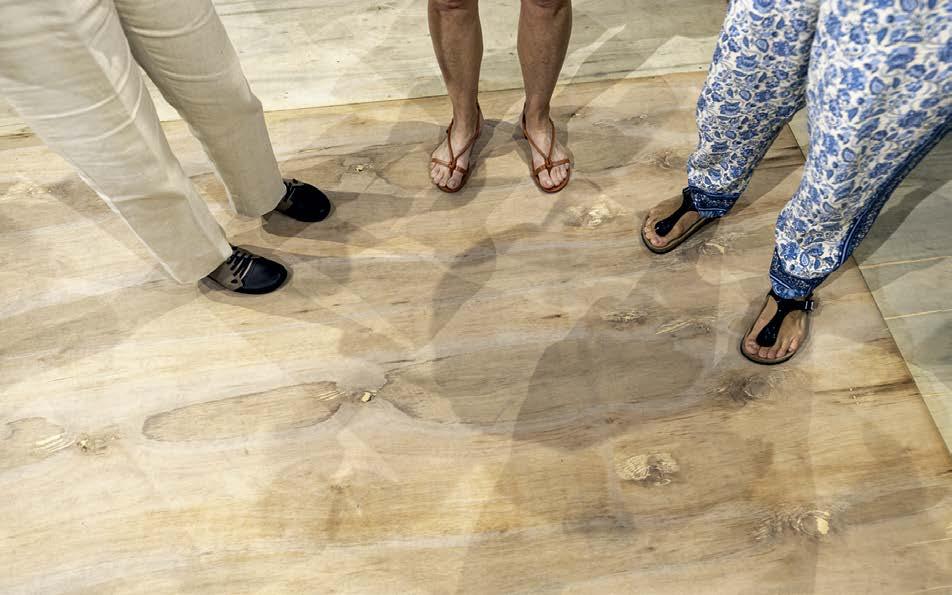
Nos seus últimos trabalhos, a partir de “When the matter is gone”, sua obra parece mais interessada no desaparecimento da matéria, na desmaterialização e na propagação de energia. Ao mesmo tempo, suas esculturas parecem ainda voltadas para a “estruturação de corpos densos”. O que te interessa nesta dialética entre matéria e energia, entre visível e invisível? Eu não acredito no desaparecimento da matéria, pelo menos não nesse desaparecimento que é ligado a uma ideia de inexistência, não presença ou algo que remeta a isso. No geral, acredito na presença e existência de tudo aquilo que parece não habitar lugar algum. E nesse habitar, a contradição tem sido cada vez mais presente, e o título “When the matter is gone” é um pouco deságue dessa perspectiva que trago, isto porque, o que por vezes chamamos de “desmaterialização”, muitas vezes está vinculado ou pautado em uma experiência de ausência de fatores ligados à visualidade, e a outros sentidos como tato, auditivo e olfativo, ou seja, nesse caminho de não encontrar os fatores comuns ao que dá a base para uma ideia de algo “ser ou estar” material. Quando, ao contrário, aquilo que atinge um estado de matéria que supera a deflagração por qualquer uma dessas vias permanece sendo tão material e presente quanto um bloco de concreto, uma ideia ou um fragmento de um átomo. E aí habita um pouco minha curiosidade… Nessa possibilidade elástica e metamórfica infinita que a matéria nos apresenta, e nesse movimento venho me aproximando dessas outras corporalidades e movimentos cada vez menos presentes aos olhos e, ao mesmo tempo, sigo conformando aquilo que você colocou como uma “estruturação de corpos densos”, uma vez que, por mais que aparentemente polarizados, na verdade são movimentos complementares de uma mesma discussão.
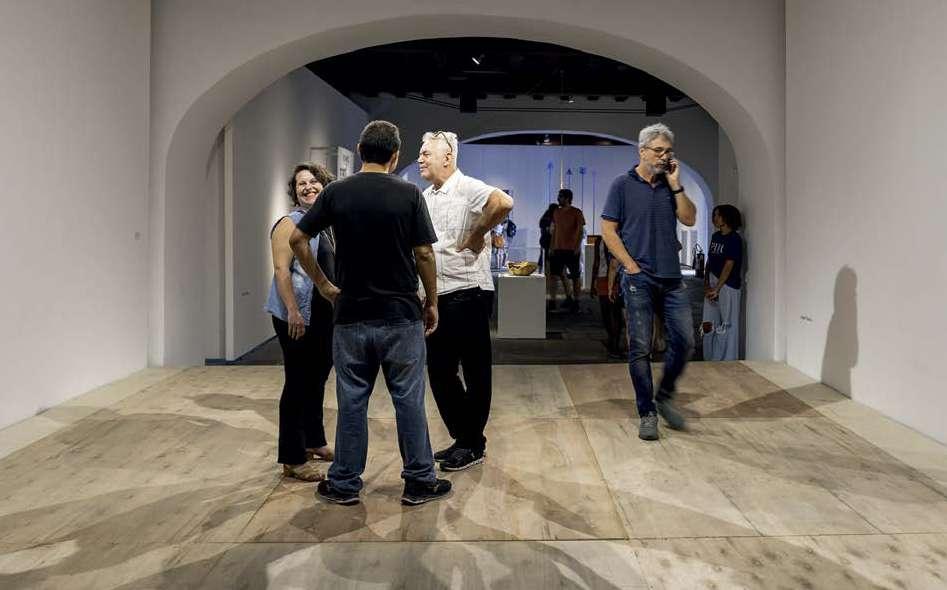
premiopipa.com // pipaprize.com 69 68 institutopipa.com
Tremor 2023, escultura, exposição do Prêmio PIPA 2023 no Paço Imperial do Rio de Janeiro, RJ, fotos de Fabio Souza // Tremor 2023, sculpture, PIPA Prize 2023 exhibition at Paço Imperial do Rio de Janeiro, Brazil, photo by Fabio Souza
